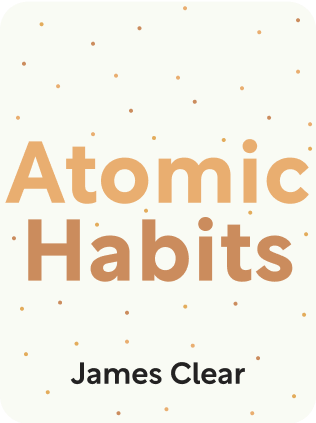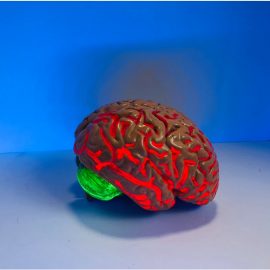

This article is an excerpt from the Shortform book guide to "Atomic Habits" by James Clear. Shortform has the world's best summaries and analyses of books you should be reading.
Like this article? Sign up for a free trial here .
What are the 4 laws of atomic habits? How can following these laws help you build new, positive habits?
The 4 laws of atomic habits are a simple set of rules we can use to establish new habits: 1) make it obvious, 2) make it attractive, 3) make it easy, and 4) make it satisfying. Think of these laws as a framework for designing each stage for optimal habit formation. To break bad habits, simply invert the laws from positive to negative.
Keep reading to learn about the 4 laws of atomic habits.
What Are the 4 Laws of Atomic Habits?
The 4 laws of atomic habits are derived from the four stages of habit formation. These stages are the cue, the craving, the response, and the reward. Every habit you have is linked to these four stages.
The cue is the element that triggers the brain to notice an opportunity for a reward, or pleasure. A cue can be a smell, a sound, an event, an interaction, or anything else that triggers a desire. This desire is known as the craving.
The craving is the emotional relevance attached to a certain cue. When you notice the cue, the brain anticipates an opportunity for a change in your physical or emotional state. You crave the satisfaction that change will elicit, and this craving is what prompts you to act.
The response is the actual behavior, or habit, performed to elicit the change you desire. Your brain prompts you to take a certain action it believes will create the feeling of satisfaction you want.
The reward is the satisfaction gained from the action taken. You have successfully satisfied your craving and changed your physical or emotional state. The brain builds a pathway from the cue to this state of pleasure. Every time you experience the same cue, the brain will be triggered to desire that pleasure again. You will be prompted to perform the same action, thereby creating a habit.
Habit Process
The process works like this:
Cue: You walk past a coffee shop on the way to work and smell fresh roasted coffee.
Craving: Coffee gives you energy, and you want to feel energized.
Response: You buy a cup of coffee.
Reward: By the time you reach work, you are raring to go. Buying a cup of coffee becomes associated with your walk to work.
If one of these stages fails, the habit will not be formed.
- If you remove the cue, your brain is not activated.
- If you remove the craving, you have no need to act.
- If the response is too hard, you won’t be able to do it or won’t try.
- If the reward is not satisfying, you have no reason to want to attain it again.
Atomic Habits: 4 Laws of Habit Formation
In Atomic Habits, 4 laws are derived from these stages. Think of these laws as a framework for designing each stage for optimal habit formation.
Cue: Make It Obvious
Because habits are automatic behaviors, you likely don’t notice every cue triggering you to act. Therefore, the first step in creating cues that lead to good behaviors is to become aware of them.
Become Aware of Habits
Make a habit scorecard to list all your current habits performed daily. Because behaviors influence each other, the end of one habit often serves as a cue for another. When you list your habits, you’re able to see which actions precede them and which follow. By listing your cues and rewards in this way, you will see what current behaviors may be suitable to cue new desired behaviors.
Use Awareness to Your Advantage
You can exploit the habit scorecard in two ways to form better habits.
The first is implementation intention, wherein you make an advanced plan for a new behavior by assigning a specific time and place for it. Research suggests that activities set for specific times are more likely to be followed through.
- If your scorecard shows a gap in activities between 12:30 pm and 1:30 pm, you might find an opportunity to schedule a new behavior during that time.
- You decide that at 12:30 pm, you will walk around the block for 20 minutes to exercise. Each day at 12:30, you will be prompted to walk.
- The formula is: “When X occurs, I will do Y” or “At X time, I will do Y.”
This strategy makes the cue obvious by attributing a specific time and place to the behavior.
The second is habit stacking. This technique links a new behavior to a current one by allowing the reward to become the new cue.
- Rather than setting a specific time for your walk, you decide you will walk every day after lunch. The end of lunch now becomes the cue to walk.
- The formula is: “After I do X, I will do Y.”
This strategy makes the cue obvious by attaching a desired habit to a fully formed habit.
The most important elements involved in making a cue obvious are 1) to be as specific as possible in the behavior that will follow and 2) ensure that the cue is realistic.
- Saying, “I will walk on my lunch break” is less specific than “I will walk around the block [specific location] after eating lunch [specific cue] for 20 minutes [specific intention].” The new action is easier to take when the questions about where, when, and how are already answered.
- However, if you only have 30 minutes for lunch, planning a 20-minute walk is not a realistic expectation. Likewise, if 12:30 pm is when you watch the news, you will create a conflict in your current routine by scheduling a new activity at the same time. The logistics surrounding a new behavior must support its implementation.
Craving: Make It Attractive
For your cravings to lead to action, the possible reward must be attractive. Cravings involve the sensations of wanting—the anticipation of pleasure—and liking—the experience of pleasure. Both sensations trigger the production of dopamine in the brain, or the chemical involved in desire, but 90% of dopamine production is dedicated to wanting. The anticipation of something outweighs the pleasure of receiving that thing.
- Think about how much more excited you are before a date than when on the date. If it’s a first date, you anticipate making a connection, which excites you. If, when you’re on the date, you have a good time but don’t feel a strong connection, you won’t want to continue dating that person.
- However, if you feel a connection, you will crave a second date because you desire to feel that connection again. It’s the promise of continued connection that keeps you motivated to date this person.
If anticipation is the greatest craving, you must create more promise for the rewards your actions lead to. There are two ways that rewards can be heightened to create stronger desires.
Heightened Rewards
Temptation bundling is one way to make any behavior more attractive. Like habit stacking, use the end of a new behavior as a cue for something that excites you. This helps make the new behavior more enticing.
- You’ve set up the end of lunch as a cue to walk for 20 minutes, but you don’t feel driven to walk because you’d rather play video games. If playing video games for 20 minutes becomes the reward for walking, you’ll begin to crave the walk so you can claim your reward afterward.
- The formula is: After X [current habit], I will do Y [new habit]. After I do Y, I get to do Z [craved habit].”
Redefining your behaviors can also make them more appealing. Rather than thinking about having to walk 20 minutes a day, change the perspective to getting to walk 20 minutes a day. This small change in perspective highlights the positive elements of walking. You begin to see how fortunate you are to have the ability to walk and the time in your day to do so. When you feel gratitude for the activities you’re able to participate in, you’ll be more driven to keep participating.
Response: Make It Easy
You will only follow through on behaviors that are easy to perform and require little effort. That is simply human nature. Therefore, to stay motivated, make behavior as effortless as possible.
But making behaviors easy doesn’t mean only doing easy things. The idea is to make it easy for you to keep showing up for the behavior you want to perform. By simply showing up, you maintain your desired identity, which gives you pride and confidence to keep making progress.
Making Behaviors Easier
Reducing the effort of an action means removing the friction existing between you and the behavior. The more friction there is, the less likely you are to act.
- If you want to eat a healthier breakfast, remove friction by setting out the items required before bed.
- If you want to read more before bed, place a book on your pillow after waking up each morning.
The two-minute rule is also effective in making behaviors easier. Often, you jump into the biggest changes required when trying to build new habits or start new behaviors. But big changes in behavior are hard to maintain over time. You will make more progress if you break the behavior down into tiny two-minute increments. These increments will build into massive achievements.
- You want to start jogging and decide to jog for 20 minutes each day after work. You are successful for a few days, but on the fourth day, you’re too tired, so you skip it. Suddenly, the behavior has stopped.
- However, you likely have enough energy to lay out your running clothes, and it only takes two minutes. Or better yet, you’ve laid out running clothes before leaving for work to reduce friction. The next step is to put them on. The next step after that is to put on your shoes. Then, leave the house. Then, walk to the sidewalk. Each of these two-minute actions connect to get you to the point of being ready to run. The obstacles to overcome are small compared with the overwhelming idea of running for 20 minutes.
- Some days, you may only get as far as changing into the clothes, but that small act is still a vote cast for your identity as a jogger and is still considered a victory.
Small successes motivate you to achieve others. Commit to two-minute actions at a time, and it will be easier to perform each required step until you have achieved the full habit.
Reward: Make It Satisfying
If the end result of your efforts is unenjoyable, why would you want to do them again? You wouldn’t, which is why rewards need to be satisfying for habits to form.
Many rewards you receive are delayed. You only receive a paycheck after weeks of work. You only get a final grade after months of studying. But human nature is wired to want instant gratification, and most good behaviors need time before the positive results accumulate. You sacrifice now to benefit later. To stay motivated to continue good habits, find ways to create rewards that are instantly satisfying.
Adding Instant Gratification to Rewards
Reinforcements are good motivators for continued action. You remember the end of behavior more than any other part. Therefore, make the end of your behavior rewarding with a reinforcement to motivate continued action.
- You won’t notice a major difference in your savings account after a week if you deposit one dollar a day. The reward of more financial freedom is too far down the road to elicit immediate pleasure. But the act of saving a dollar a day can be rewarding with a small reinforcement. Each time you deposit a dollar into your savings, give yourself an hour of relaxation, a cookie, or an extra 30 minutes of television. You’ll feel motivated to keep saving if you end the action with something gratifying.
- Whatever the reinforcement is, it must be satisfying and instantly received.
Habit tracking can also make behaviors more rewarding. Create visual representations of your progress by marking a day on a calendar, transferring pebbles from one jar to another, or keeping a journal log of your completed actions. When you can visually see your accomplishments, you’ll be motivated to continue acting.
The act of tracking can feel rewarding in and of itself. It is satisfying to mark each successful completion of an action in some way. The pleasure experienced through that act becomes a cue to want to feel that satisfaction again.
Only track one major habit at a time to avoid becoming overwhelmed by the act.
Invert the 4 Laws of Atomic Habits to Break Bad Behaviors
You likely have habits you wish you didn’t. To break bad habits, invert the laws from positive to negative in the following way:
- Cue—Make it invisible.
- Craving—Make it unattractive.
- Response—Make it difficult.
- Reward—Make it unsatisfying.

———End of Preview———
Like what you just read? Read the rest of the world's best book summary and analysis of James Clear's "Atomic Habits" at Shortform .
Here's what you'll find in our full Atomic Habits summary :
- The 4 Stages of Habit Formation you can use to transform your life
- How more than half of your daily actions are automatic
- Why some habits stick and why others won't






